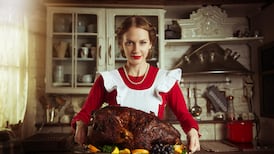Your day has gone horribly wrong. There’s more bad news on the radio and it’s just started to hurl rain. You start to dream about dinner. Not a crisp green salad but a plate of buttery mash and a thick steak, with apple tart and cream to finish.
Comfort eating and what makes us do it is at the heart of new research in Univerity College Cork. Mice in the university’s laboratory may hold the key to understanding why we crave high fat, carbs, salt and sugary foods in times of stress. It’s timely research, especially in Ireland, when the urge for apple crumble as everything crumbles around us may have led us to comfort-eat our way through the recession.
The knowledge around emotional eating is growing. In a 2011 study published in the journal Neuroscience, a team led by UCC neuroscientist Prof John Cryan found that mice who ate more comfort foods reacted with less anxiety to stressful situations. At the heart of the research into what drives mice, and us, towards the comfort food is a hormone called ghrelin. This hormone, discovered by scientists in Japan in 1999, has been dubbed the "hunger hormone".
“It is released from the stomach in anticipation of food and basically tells the brain and digestive systems to get ready for eating,” Prof Cryan explains.
In the past two years the UCC researchers, along with scientists in the US and Sweden, have zoned in on ghrelin and how it prompts those cravings for high-calorie palatable foods. Put simply, in response to stress the mice produce more ghrelin which prompts them to eat more comfort foods, over-riding normal appetite urges. “The role of chronic daily stress on how ghrelin signals to the brain is the subject of intense investigation at UCC and understanding these pathways may result in a better understanding of why we comfort eat and how to prevent it,” Cryan says.
The idea of emotional eating may explain how Irish food businesses are surviving such a difficult business climate. We may not be taking three holidays a year anymore but we’re not giving up those trips to Fallon & Byrne or Cork’s English Market. Dublin’s restaurant scene is booming. Despite years of austerity, consumers are buying more foods that are considered luxuries. Last year, sales of farmhouse cheese in Ireland rose by 43 per cent to create a €4 million domestic market.
Karen Liston of Listons on Dublin's Camden Street has seen customers continue to treat themselves to good ingredients through the downturn.
“People of all ages are coming in looking for unusual spice mixes, like ras el hanout or baharat seven spice, or pomegranate molasses.” She puts some of this down to the Ottolenghi effect (the London-based chef) and believes that cookery programmes and books are “getting us excited about cooking and food”.
Along with the exotic requests, there has also been a noticeable shift towards Irish food among her customers. “They want to support local artisan producers. They are aware it’s supporting jobs in Ireland. Toonsbridge buffalo mozzarella is very popular, Gubbeen Smokehouse chorizo sausages; Le Levain and Tartine bakery are two amazing bakeries producing delicious bread.”
Liston has also noticed that her shoppers are more careful. “I particularly see it with the fresh veg, where people will buy one carrot or one onion or they want a small piece of cheese. People want to avoid waste. They’re shopping off lists and more often than not, they know what they want.”
Kevin Sheridan of Sheridans Cheesemongers has seen a similar emphasis on Irish food among his customers. "After a decent-sized crash in 2008 and 2009, sales have been slowly increasing. Galway and Waterford were worst hit and slowest to recover, but in the last year they are definitely coming alive again.
“Product-wise there has definitely been a much bigger emphasis on Irish food, partly because we have pushed it and partly because customers have looked for more Irish. I would say that bigger than the effect of people having less money has been a stronger awareness of what they spend their money on. So even if they are spending the same amount on what some would describe as luxury food, they want to have value and that value can be derived from supporting Irish jobs as much as price value.”
So, while our impulses may have a comfort element to them, many of us have become more thoughtful and patriotic in how we eat in this recession.
The comfort factor also might explain why baking is now huge. Nine million viewers in Britain settled onto sofas to watch the final of the Great British Bake Off.
A spokesman for Irish flour manufacturer Odlums said its market has been increasing steadily over the past three years. “In 2012 it saw a small decline, but has seen steady growth again in 2013, nothing dramatic but growing nevertheless.”
This magazine's recipe writer Domini Kemp sees the biggest reader reaction to recipes for the old classics, redone. Her stews, a "blonde" lasagne, meatballs, and an onion and Gruyère tart have all hit a rich seam.
“It’s the foods that people associate with eating when they were kids, the ones that are utterly familiar.” Happy food like chocolate birthday cakes get plenty of attention, too. And Kemp sees this in her cafe and restaurant business. Homemade sausage rolls, Cornish pasties and potato salad are solid-selling cafe staples. In Hatch & Sons on Stephen’s Green, customers regularly come just for the beef and Guinness stew.
“You even see it in food photography. In the 1990s and early 2000s you had all this clean, blasted white light, casual chic dining, beaches in Australia, that kind of stuff. Now everything is Nordic and darker tones, not as fake in one way.” That homeliness is a “real reflection of how people feel,” Kemp says.
Cookery writer Lilly Higgins loves healthy recipes but her chocolate peanutbutter cake has brought more visitors to her blog than any other recipe.
The luscious sponge with easily an inch of butter icing sprinkled with dry roasted peanuts is her most visited post ever. She imagines that lots of readers are eating the image with their eyes, getting comfort from looking at a truly old fashioned butter-laden sponge and imagining the salt and sweet combination. “A lot of them would be sitting at their desks in an office and maybe eating Ryvita with grapes for their lunch,” she says.
Running into the arms of comfort foods our Mammies might have given us is something that Higgins believes is at the heart of what we crave.
Are people actually making her recipes or just enjoying the thought of them? “I think people are making them at weekends,”she says.
“It’s such a pleasurable activity. Your house fills up with smells, you’re crumbling butter into flour and then you get to eat it at the end.”













